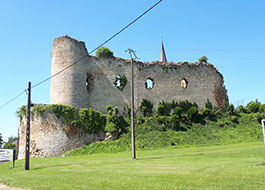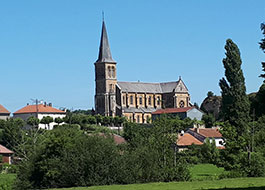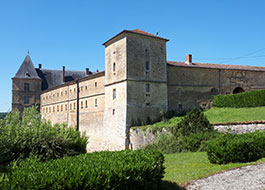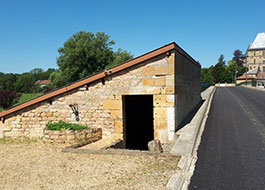Louppy-sur-Loison
Durée visite : 45 minutes
Moyen : Pédestre
Au haut Moyen Âge, Louppy devient une forteresse avec deux châteaux réunis par ses murailles. Au XIIIe siècle, le village est partagé entre les seigneuries de Marville et Stenay. En 1633, Simon II de Pouilly, gouverneur lorrain de Stenay, devient comte de Louppy. Il organise un marché hebdomadaire et fait construire un château Renaissance. Louis XIV y séjourne.
In the early Middle Ages, Louppy became a fortress with two castles joined by its walls. In the 13th century, the village was shared between the seigneuries of Marville and Stenay. In 1633, Simon II de Pouilly, Lorraine governor of Stenay, became count of Louppy. He organized a weekly market and built a Renaissance castle. Louis XIV stayed there.
Im frühen Mittelalter wurde Louppy eine Festung mit zwei Burgen, die durch ihre Mauern verbunden waren. Im 13. Jahrhundert wurde das Dorf zwischen den Seigneuries Marville und Stenay geteilt. Im Jahr 1633 wurde Simon II de Pouilly, lothringischer Gouverneur von Stenay, Graf von Louppy. Er organisierte einen Wochenmarkt und baute ein Renaissance-Schloss. Ludwig XIV. Blieb dort.
Les points de visites
.
Au cœur du village, à proximité de l’église, les vestiges d’une tour et d’une courtine sont encore visibles. Sur un plan de 1700, le château apparaissait sous la forme d’un quadrilatère accosté de quatre tours d’angles. Il possédait autrefois de profondes douves alimentées par le Loison tout proche. Outre le rôle défensif de l’édifice, sa fonction résidentielle parait certaine. Une cheminée et de banquettes sous les fenêtres en attestent. Ces vestiges dateraient sans doute du XIIIe ou XIVe siècle. Mais la première mention d’un château est signalée à la fin du XIIe siècle comme propriété du comte de Bar Thibaut Ier. Ensuite, la seigneurie de Louppy sera partagée entre différentes familles jusqu’à l’arrivée de la famille de Pouilly au XVIe.
In the heart of the village, near the church, the remains of a tower and a curtain wall are still visible. On a 1700 plan, the castle appeared as a quadrangle with four corner towers. It once had a deep moat fed by the nearby Loison. Besides the defensive role of the building, its residential function seems certain. A fireplace and benches under the windows attest to this. These remains undoubtedly date from the 13th or 14th century. But the first mention of a castle is reported at the end of the 12th century as the property of the Count of Bar Thibaut I. Then, the seigneury of Louppy will be shared between different families until the arrival of the Pouilly family in the 16th century.
Im Herzen des Dorfes, in der Nähe der Kirche, sind noch die Überreste eines Turms und einer Vorhangfassade sichtbar. Nach einem Plan von 1700 erschien die Burg als Viereck mit vier Ecktürmen. Es hatte einmal einen tiefen Wassergraben, der vom nahe gelegenen Loison gespeist wurde. Neben der defensiven Rolle des Gebäudes scheint seine Wohnfunktion sicher zu sein. Ein Kamin und Bänke unter den Fenstern zeugen davon. Diese Überreste stammen zweifellos aus dem 13. oder 14. Jahrhundert. Die erste Erwähnung einer Burg wird jedoch Ende des 12. Jahrhunderts als Eigentum des Grafen von Bar Thibaut Ier gemeldet. Dann wird das Seigneury von Louppy bis zur Ankunft der Familie Pouilly im 16. Jahrhundert zwischen verschiedenen Familien aufgeteilt.
.
L’église Saint-Martin est de style néo-roman et date de 1878. Elle est édifiée sur les ruines de l’ancien château fort. Elle prend la forme d’une croix latine composée de trois vaisseaux avec un transept saillant se terminant par un chevet à trois pans. La grandeur et le volume surprenant de l’église contrastent avec celles des villages environnants. Mais la population de l’époque a atteint plus de 500 habitants au XIXe siècle. Une loterie et une souscription en vue de financer son ameublement furent lancées. La Lorraine, mais aussi de nombreux départements français et des villes de Belgique et du Grand-Duché de Luxembourg y participèrent. À l’intérieur, en plus du mobilier néo-roman, les vitraux gardent le souvenir des anciennes familles du village, notamment celle des Vassinhac d’Imécourt.
The Saint-Martin church is in neo-Romanesque style and dates from 1878. It is built on the ruins of the old castle. It takes the form of a Latin cross composed of three vessels with a projecting transept ending in a three-sided apse. The size and surprising volume of the church contrast with those of the surrounding villages. But the population of the time reached more than 500 inhabitants in the 19th century. A lottery and a subscription to finance its furnishings were launched. Lorraine, but also many French departments and cities in Belgium and the Grand Duchy of Luxembourg participated. Inside, in addition to the Neo-Roman furniture, the stained-glass windows keep the memory of the old families of the village, in particular that of Vassinhac d´Imécourt.
Die Saint-Martin-Kirche ist im neoromanischen Stil erbaut und stammt aus dem Jahr 1878. Sie wurde auf den Ruinen der alten Burg erbaut. Es hat die Form eines lateinischen Kreuzes aus drei Gängen mit einem vorspringenden Querschiff, das in einer dreiseitigen Apsis endet. Die Größe und das überraschende Volumen der Kirche stehen im Gegensatz zu denen der umliegenden Dörfer. Aber die Bevölkerung der damaligen Zeit erreichte im 19. Jahrhundert mehr als 500 Einwohner. Eine Lotterie und ein Abonnement zur Finanzierung der Einrichtung wurden ins Leben gerufen. Lothringen, aber auch viele französische Departements und Städte in Belgien und das Großherzogtum Luxemburg nahmen daran teil. Im Inneren erinnern die Buntglasfenster neben den neorömischen Möbeln an die alten Familien des Dorfes, insbesondere an die von Vassinhac d´Imécourt.
Le château de Louppy-sur-Loison propose par sa monumentalité, la richesse de son décor, ainsi que par son histoire, l’un des plus étonnants exemples de style Renaissance de la région. Il fut édifié dans la première moitié du XVIIe siècle par Simon II de Pouilly, maréchal de Barrois, gouverneur de Stenay attaché au duc de Lorraine. Achevé en 1633, ce projet architectural unique, dont l’intérêt devait affirmer la puissance de son commanditaire, permettait entre autres d’accueillir le duc et sa cour. Louis XIV y résida pendant le siège de Montmédy en 1657. Lors de la Première Guerre mondiale, il fut pillé par l’armée allemande. Lors de la Seconde Guerre mondiale, Louppy servit de camp de prisonniers. Le château possède différentes cours, ainsi que des portails et porches sculptés d’un intérêt majeur dans le patrimoine régional. La basse cour est centrée autour d’un grand colombier bien conservé. La cour d’honneur présente une richesse sculpturale concentrée sur trois portails monumentaux. L’un représente les quatre éléments et des scènes mythologiques. De la cour d’honneur, on accède par un portail à la chapelle, qui conserve le souvenir de l’abbaye bénédictine voisine de Juvigny. Un parc à l’anglaise, avec des essences rares, longe le Loison.
The castle of Louppy-sur-Loison offers by its monumentality, the richness of its decor, as well as its history, one of the most astonishing examples of Renaissance style in the region. It was built in the first half of the 17th century by Simon II de Pouilly, Marshal de Barrois, governor of Stenay attached to the Duke of Lorraine. Completed in 1633, this unique architectural project, the interest of which was to affirm the power of its sponsor, made it possible, among other things, to accommodate the Duke and his court. Louis XIV lived there during the siege of Montmédy in 1657. During the First World War, it was looted by the German army. During World War II, Louppy served as a prison camp. The castle has different courtyards, as well as carved portals and porches of major interest in the regional heritage. The farmyard is centered around a large, well-preserved dovecote. The main courtyard presents a sculptural richness concentrated on three monumental portals. One represents the four elements and mythological scenes. From the main courtyard, you access the chapel through a portal, which preserves the memory of the neighboring Benedictine abbey of Juvigny. An English park, with rare species, runs along the Loison.
Das Schloss von Louppy-sur-Loison bietet durch seine Monumentalität, den Reichtum seiner Dekoration sowie durch seine Geschichte eines der erstaunlichsten Beispiele für den Renaissancestil der Region. Es wurde in der ersten Hälfte des 17. Jahrhunderts von Simon II. De Pouilly, Marschall de Barrois, Gouverneur von Stenay, erbaut, der dem Herzog von Lothringen angegliedert war. Dieses einzigartige Architekturprojekt, dessen Interesse darin bestand, die Macht seines Sponsors zu bekräftigen, wurde 1633 fertiggestellt und ermöglichte unter anderem die Unterbringung des Herzogs und seines Hofes. Ludwig XIV. Lebte dort während der Belagerung von Montmédy im Jahre 1657. Während des Ersten Weltkriegs wurde es von der deutschen Armee geplündert. Während des Zweiten Weltkriegs diente Louppy als Gefangenenlager. Das Schloss verfügt über verschiedene Innenhöfe sowie geschnitzte Portale und Veranden, die für das regionale Erbe von großem Interesse sind. Der Hof ist um einen großen, gut erhaltenen Taubenschlag zentriert. Der Haupthof präsentiert einen skulpturalen Reichtum, der sich auf drei monumentale Portale konzentriert. Eines repräsentiert die vier Elemente und mythologischen Szenen. Vom Haupthof aus gelangen Sie über ein Portal zur Kapelle, das die Erinnerung an die benachbarte Benediktinerabtei von Juvigny bewahrt. Ein englischer Park mit seltenen Arten verläuft entlang des Loison.
Il est installé sur les bords du Loison. La fréquentation des lavoirs était exclusivement féminine. Elles pouvaient toutefois y emmener leurs enfants quand elles n’avaient personne pour les surveiller. Les règlements de la police du lavoir punissant le mâle contrevenant. Certaines femmes s’y rendaient à titre personnel tandis que d’autres y exerçaient les métiers de lavandières, laveuses ou blanchisseuses.
It is installed on the banks of the Loison. The frequentation of the wash houses was exclusively female. They could, however, take their children there when they had no one to look after them. Laundromat police regulations punishing the offender male. Some women went there in a personal capacity while others worked there as washerwomen, washerwomen or laundresses.
Es ist am Ufer des Loison installiert. Die Besucher der Waschhäuser waren ausschließlich weiblich. Sie konnten jedoch ihre Kinder dorthin bringen, wenn sie niemanden hatten, der sich um sie kümmerte. Waschsalon-Polizeivorschriften zur Bestrafung des männlichen Täters. Einige Frauen gingen persönlich dorthin, während andere dort als Wäscherinnen, Wäscherinnen oder Wäscherinnen arbeiteten.
Adam de Menthon, chanoine de la collégiale Sainte-Madeleine de Verdun, fonde hors des remparts l’église de la Madeleine. Un ermitage l’aurait précédée. La nef remonte au XIe siècle comme l’attestent les ouvertures romanes. Elle fut prolongée par la suite d’un nouveau chœur voûté en ogive au XVIe siècle. La particularité de cette église tient essentiellement au retable datant de la fin du XVe siècle l’un des plus bels exemples connus dans la région. En 1840, à la demande du comte Charles de Wassinhac, fut aménagé une chapelle funéraire ouverte sur le chœur, pour y enterrer les membres de leur famille. Elle est entièrement décorée de fresques évoquant la Résurrection et les différents apôtres. On y retrouve le fondateur de la chapelle en habit de pair de France, ainsi que toutes les armoiries des seigneurs de Louppy, de l’origine jusqu’à la Révolution. Une Croix de cimetière, en pierre, du XVIe siècle, est adossée au chevet de la chapelle de la Madeleine.
Adam de Menthon, canon of the Sainte-Madeleine collegiate church in Verdun, founded the Church of the Madeleine outside the ramparts, a hermitage said to have preceded him. The nave dates back to the 11th century as evidenced by the Romanesque openings. It was subsequently extended by a new ogive vaulted choir in the 16th century. The particularity of this church is mainly due to the altarpiece dating from the end of the 15th century, one of the most beautiful examples known in the region. In 1840, at the request of Count Charles de Wassinhac, a funeral chapel was set up open to the choir, to bury members of their family. It is entirely decorated with frescoes evoking the Resurrection and the various apostles. We find there the founder of the chapel in the habit of a peer of France, as well as all the coats of arms of the Lords of Louppy, from the origin until the Revolution. A 16th century stone cemetery cross leans against the chevet of the Madeleine chapel.
Adam de Menthon, Kanoniker der Stiftskirche Sainte-Madeleine in Verdun, gründete die Kirche der Madeleine außerhalb der Stadtmauern, eine Einsiedelei, die ihm vorausgegangen sein soll. Das Kirchenschiff stammt aus dem 11. Jahrhundert, wie die romanischen Öffnungen belegen. Es wurde später im 16. Jahrhundert um einen neuen ogiven Gewölbechor erweitert. Die Besonderheit dieser Kirche ist hauptsächlich auf das Altarbild aus dem Ende des 15. Jahrhunderts zurückzuführen, eines der schönsten in der Region bekannten Beispiele. Auf Wunsch des Grafen Charles de Wassinhac wurde 1840 eine für den Chor geöffnete Bestattungskapelle errichtet, um Mitglieder ihrer Familie zu begraben. Es ist vollständig mit Fresken geschmückt, die an die Auferstehung und die verschiedenen Apostel erinnern. Wir finden dort den Gründer der Kapelle in der Gewohnheit eines Gleichaltrigen Frankreichs sowie alle Wappen der Lords of Louppy vom Ursprung bis zur Revolution. Ein steinernes Friedhofskreuz aus dem 16. Jahrhundert lehnt sich an den Chevet der Madeleine-Kapelle.










